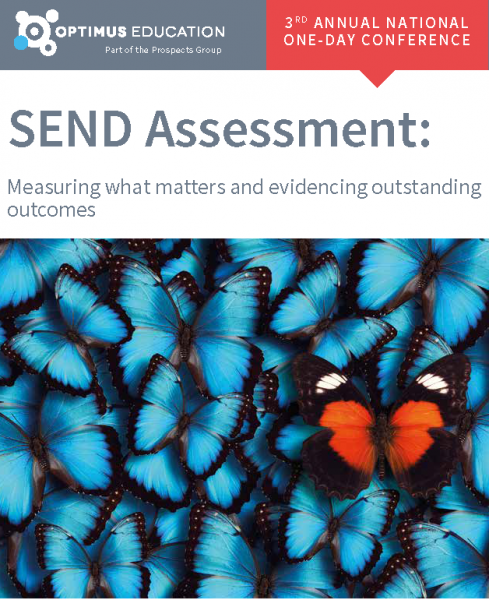A considered review of different assessment methods, along with a recognition of the importance of accountability and equal opportunity, shaped the Review's final report.

This is the first post in a three-part series on what the Rochford Review recommendations mean for schools. Follow the links below to read more from Richard:
You can also read the DfE's response to the consultation on the Rochford Review recommendations for information about the next steps.
After a protracted period of delay caused mainly by Brexit, the final report of the Rochford Review was published on 19th October 2016 with ten recommendations.
In the chair’s introduction to the final report, Diane Rochford described some important issues around the statutory assessment of pupils working below the standard of national curriculum tests. She stated that:
These comments crystallised what I also felt to be essential in the education and therapeutic care of pupils who have learning disabilities:
The first cycle of meetings concerning the Rochford Review was focused very much on the statutory assessment of pupils working at subject-specific standards (P5 and above) and ensuring these pupils could be better included in the newly introduced end-of-key-stage statutory assessments and tests.
The final report recommended that the pre-key stage standards should, as recommended in the Rochford Review interim report, be made permanent. This recommendation was made with a general understanding that pupils should only be entered for statutory assessment when they are academically ready to participate and in ways that are empathetic to their individual circumstances – particularly so for pupils with English as an Additional Language (EAL).
The review recognised the difficulties which schools face in accurately assessing pupils with EAL and members regularly debated items such as:
Members agreed that a much deeper review of EAL was necessary than that which could be achieved within the scope of the review and this request was made as one of the final recommendations.
Optimus members can read our full Q&A with Richard on the journey to the final report and its implications for schools.
Research evidence demonstrated that use of the Engagement Profile Scale was the most reliable method for predicting the likelihood of the lowest attaining pupils acquiring new concepts and skills.
In the cycle of meetings preceding the final report, members engaged in some heated discussions about how best to statutorily assess pupils working below the standard of subject-specific learning (P4 and below).
There was unanimous agreement that statutory assessment should support the ambitions of SEND-related legislation, such as the introduction of EHC plans, but not total agreement about methodology.
The fact that pupils working at P4 and below do not learn in a linear way tended to be at the core of the most heated discussions, delaying any agreement on what method of statutory assessment would be most appropriate.
Because the P levels are organised in a linear way, any proposal to simply ‘revise’ P levels 1-4 was not felt to be appropriate, but before P levels could be rejected, a better alternative was required.
Members agreed that the overriding criterion for the consideration of different statutory assessment approaches should be that all proposals would have to be supported by sound research. Examples from the Welsh Assembly (Routes for Learning), the Northern Ireland Office (Quest for Learning) and other examples such as the north of England MAPP method were acknowledged as being of particular worth.
However, it was the DfE’s ‘Complex Learning Difficulties and Disabilities Project’ (CLDD 2011) that attracted the most interest.
The CLDD project had demonstrated that pupil propensity for making progress in cognition and learning (for all pupils, not just those with learning difficulties and disabilities) is always dependent on how well a pupil is engaging in the process of learning. Because of its commonality to pupils of all abilities, members agreed that assessing variations in pupil engagement might offer a solution to the problem of ensuring any proposed change in the statutory assessment of pupils working at P1-4 would include an element of inclusivity with all other pupils.
CLDD research evidence reliably demonstrated that pupil engagement was made up of various aspects which could be monitored objectively to identify:
The CLDD project had trialled an Engagement Profile Scale (and continues to do so) that enables teachers to monitor and accurately predict the likelihood of a pupil acquiring a new concept or skill by reference to how well a pupil is engaging in the learning process.
Research evidence also demonstrated that use of the Engagement Profile Scale was the most reliable method for predicting the likelihood of the lowest attaining pupils acquiring new concepts and skills.
To summarise, the CLDD methodology offered an inclusive approach to assessment that was particularly relevant to the lowest attaining pupils and which had cognition and learning at its core.
Given that testing a pupil’s standard of cognition in mathematics and English is the purpose of statutory assessment in the new national curriculum, members agreed that use of the Engagement Profile Scale to assess the earliest stages of cognition and learning offered a viable, inclusive solution.
Having reached this agreement, the review undertook close scrutiny of the CLDD definitions of pupil engagement and after making some very minor amendments made the recommendation that pupils not engaged in subject specific learning should be statutory assessed against the 7 aspects of cognition and learning, or engagement.
However, the review was keen to stress that schools should have freedom to decide how best to assess pupils against the 7 aspects of cognition and learning.
The Rochford Review recognised ‘cognition and learning’ as being one of the EHC four areas of need as set out in the SEND Code of Practice and saw an ideal opportunity to strengthen EHC-related provision by linking EHC assessment with the recommended use of the Engagement Scale.
Members agreed that any reports provided to parents/carers about a child’s statutory assessment in cognition and learning should be given in tandem with information about their child’s progress in the other EHC areas of need.
In making these recommendations, the Rochford Review was seeking to ensure that:
As already alluded to, not all members of the Rochford Review were in full agreement with the proposal to remove P levels, but agreement was close to 100%.
At the root of these disagreements was a perceived threat to the principles of inclusive education and equal opportunity. After much debate, members agreed that the Engagement Scale offered a more inclusive approach to statutory assessment than the P levels had ever been able to offer.
The review also agreed a working definition of equal opportunity and inclusivity to guide their debates and ensure that the final report would enable pupils of all abilities to benefit from a much fairer likelihood of having their individual achievements recognised.
Peer review was considered to be one of the most effective methods of ensuring both the quality of SEND provision and standards of pupil performance.
Another issue debated within the group was a fear that removal of the P levels might undermine school accountability for standards in relation to the progress made by the lowest attaining pupils.
This concern was resolved by agreeing that, even though data returns to the DFE would not be required in respect to statutory assessment applied via the Engagement Scale, schools would have a statutory duty to provide robust evidence to support a dialogue with parents and carers, inspectors, school governors and those engaged in peer review to ensure effective accountability.
In other words, schools would have to demonstrate robust and effective provision for their pupils with SEND and be more accountable to a wider audience.
Peer review was considered to be one of the most effective methods of ensuring both the quality of SEND provision and standards of pupil performance. A specific reference to the value of peer review was made in the final report.
The Rochford Review recognised there were some schools which had already developed good practice along the lines of what was going to be recommended, so an additional recommendation was made that schools should work in partnership to share their expertise.
Schools with good SEND-related provision should be prepared to provide outreach services and schools less well prepared should actively seek partner schools to help improve the quality of their SEND provision.
Members of the Rochford Review were also sensitive to the fact that the many teachers and school leaders will never have experienced SEND provision without the overarching framework of the national curriculum and the statutory assessment framework represented by the P scale levels.
Recognising that some teachers might feel anxious about the proposed changes, the review also recommended that initial teacher training and continuing professional development should include a sound appreciation of the statutory assessment of pupils not engaged in subject-specific learning.
The third and final installment of my blog will offer schools some practical suggestions as to how the Rochford Review recommendations can be developed and applied.
This is the second blog in a three-part series written by Richard on the Rochford Review and what it means for schools. Follow the links to read more:
 What's the next step?
What's the next step?Our forthcoming 'SEND Assessment to Support Progress' conference is the only event that will give you the knowledge and strategies needed to accurately assess the progress of SEND pupils in your school, and evidence this to parents and Ofsted.
For more information and to secure your place, find out more about this crucial event.